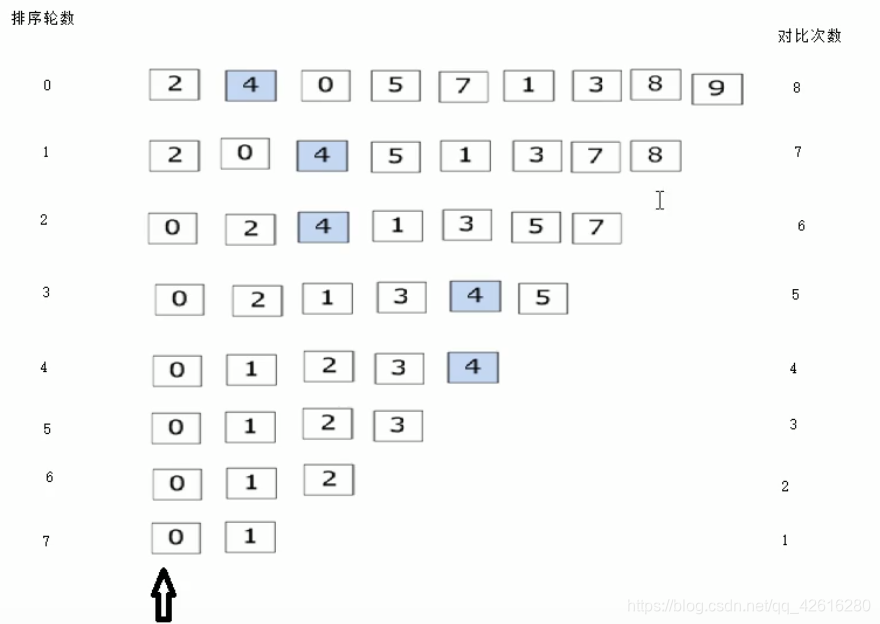一、数组
所谓数组,就是一个集合,里面存放了相同类型的数据元素
特点:
-
数组中每个数据元素都是相同的数据类型
-
数组是由连续的内存位置组成的
-
我们可以通过下标来访问数组中的元素,数组元素下标是从0开始
1、一维数组
1.数据类型 数组名[ 数组长度 ];
2.数据类型 数组名[ 数组长度 ]={
值1,值2...};
3.数据类型 数组名[ ] = {
值1,值2...};
一维数组名用途:
-
统计整个数组在内存中中的长度:sizeof(数组名)
-
获取数组在内存中的首地址:cout<<数组名<<endl;
示例: 查看数组长度和数组首地址
#include<iostream>
using namespace std;
int main()
{
int arr[] = {
1,2,3,4,5,6 };
cout << "整个数组所占内存空间:" << sizeof(arr) << endl;
cout << "每个元素占用内存空间: " << sizeof(arr[0]) << endl;
cout << "数组中元素个数:" << sizeof(arr) / sizeof(arr[0]) << endl;
cout << "数组在内存中的首地址:" << arr << endl;
cout << "数组中第一个元素地址:" << &arr[0] << endl;
cout << "数组中第二个元素地址:" << &arr[1] << endl;
system("pause");
return 0;
}
输出结果

冒泡排序
最常用的排序算法,对数组内元素进行排序
做法:
-
比较相邻的元素,如果第一个比第二个大,就交换它们两个
-
对每一对相邻元素做同样的工作,执行完毕后,找到第一个最大值
-
重复以上步骤,每次比较次数-1,直到不需要比较为止
排序总轮数 = 元素个数 - 1
每轮对比次数 = 元素个数 - 排序轮数 - 1
案例分析
给出一组数据 { 4,2,8,0,5,7,1,3,9 },按照冒泡排序的方法对其进行升序排列

示例
#include<iostream>
using namespace std;
//利用冒泡排序进行升序排列
int main()
{
int arr[] = {
4,2,8,0,5,7,1,3,9 }, count, i, j, num;
count = sizeof(arr) / sizeof(arr[0]);
cout << "给出一组数:" << arr[0];
for (i = 1; i < count; i++)
{
cout << ","<< arr[i];
}
cout << "\n对这组数进行升序排列" << endl;
for (i = 0; i < count-1; i++)
{
for (j = 0; j < count-i-1; j++)
{
if (arr[j] > arr[j + 1])
{
num = arr[j+1];
arr[j+1] = arr[j];
arr[j] = num;
}
}
}
cout << "利用冒泡排序进行升序排列后:" << arr[0];
for (i = 1; i < count; i++)
{
cout << "," << arr[i];
}
cout << "\n";
system("pause");
return 0;
}
输出结果

(2)二维数组
1.数据类型 数组名[ 行数 ] [ 列数 ];
2.数据类型 数组名[ 行数 ] [ 列数 ] = {
{
数据1,数据2},{
数据3,数据4} };
3.数据类型 数组名[ 行数 ] [ 列数 ] = {
数据1,数据2,数据3,数据4};
4.数据类型 数组名[ ] [ 列数 ] = {
数据1,数据2,数据3,数据4};
二维数组名的用途:
-
查看二维数组所占内存
-
获取二维数组首地址
示例
#include<iostream>
using namespace std;
int main()
{
int arr[2][3] = {
{
1,2,3},
{
4,5,6}
};
cout << "二维数组占用内存空间为:" << sizeof(arr) << endl;
cout << "二维数组第一行占用内存为:" << sizeof(arr[0]) << endl;
cout << "二维数组第一个元素占用内存为:" << sizeof(arr[0][0]) << endl;
cout << "二维数组行数为:" << sizeof(arr) / sizeof(arr[0]) << endl;
cout << "二维数组列数为:" << sizeof(arr[0]) / sizeof(arr[0][0]) << endl;
cout << "二维数组首地址为:" << arr << endl;
cout << "二维数组第一行首地址为" << arr[0] << endl;
cout << "二维数组第一个元素首地址为:" << &arr[0][0] << endl;
system("pause");
return 0;
}
输出结果

二、函数
将一段经常使用的代码封装起来,减少重复代码
一个较大的程序,一般分为若干个程序块,每个模块实现特定的功能
1、函数的定义:
-
返回值类型
-
函数名
-
参数列表
-
函数体语句
-
return 表达式
返回值类型 函数名(参数列表)
{
函数体语句
return表达式
}

2、函数的调用
函数名(参数);
函数定义里小括号内称为形参,函数调用时传入的参数称为实参
示例
#include<iostream>
using namespace std;
//求和
int add(int num1, int num2)
{
int sum = num1 + num2;
return sum;
}
int main()
{
int a = 10;
int b = 20;
int c = add(a, b);
cout << "a = " << a << endl;
cout << "b = " << b << endl;
cout << "c = " << c << endl;
system("pause");
return 0;
}
输出结果

3、值传递
所谓值传递,就是函数调用时实参将数值传入给形参
值传递时,如果形参发生,并不会影响实参
如果函数不需要返回值,声明的时候可以写void
示例
#include<iostream>
using namespace std;
//交换两值
void swap(int num1, int num2)
{
cout << "交换前:" << num1 << " " << num2 << endl;
int temp = num1;
num1 = num2;
num2 = temp;
cout << "交换后:" << num1 << " " << num2 << endl;
}
int main()
{
int a = 10;
int b = 20;
cout << "调用函数前:a = " << a << " b = " << b << endl;
swap(a, b);
cout << "调用函数后:a = " << a << " b = " << b << endl;
system("pause");
return 0;
}
输出结果

4、函数的常见样式
-
无参无返
-
有参无返
-
无参有返
-
有参有返
示例
#include<iostream>
using namespace std;
//1、无参无返
void test01()
{
cout << "this is test01 " << endl;
}
//2、有参无返
void test02(int num)
{
cout << "this is test02 X = " << num << endl;
}
//3、无参有返
int test03()
{
int flag = 1;
return flag;
}
//4、有参有返
int test04(int num1, int num2)
{
int sum = num1 + num2;
return sum;
}
int main()
{
test01();
int a = 10;
test02(a);
int b = test03();
cout << "this is test03 b = " << b << endl;
int c = test04(a, b);
cout << "this is test04 c = " << c << endl;
system("pause");
return 0;
}
输出结果

5、函数声明
告诉编译器函数名称及如何调用函数,函数的实际主体可以单独定义
函数的声明可以多次,但是函数的定义只能有一次
示例
#include<iostream>
using namespace std;
int add(int num1, int num2);
int main()
{
int a = 10;
int b = 20;
int c = add(a, b);
cout << "a = " << a << endl;
cout << "b = " << b << endl;
cout << "c = " << c << endl;
system("pause");
return 0;
}
int add(int num1, int num2)
{
int sum = num1 + num2;
return sum;
}
输出结果

6、函数的分文件编写
函数份文件编写一般有4个步骤:
-
创建后缀名为 .h 的头文件
-
创建后缀为 .cpp 的源文件
-
在头文件中写函数的声明
-
在源文件中写函数的定义
头文件.h
#include<iostream>
using namespace std;
void swap(int a, int b);
函数.cpp
#include"swap.h"
void swap(int a, int b)
{
int temp = a;
a = b;
b = temp;
cout << "a = " << a << endl;
cout << "b = " << b << endl;
}
主程序调用.cpp
#include"swap.h"
void swap(int a, int b)
{
int temp = a;
a = b;
b = temp;
cout << "a = " << a << endl;
cout << "b = " << b << endl;
}
【注释】 学习课程为-黑马程序C++教程